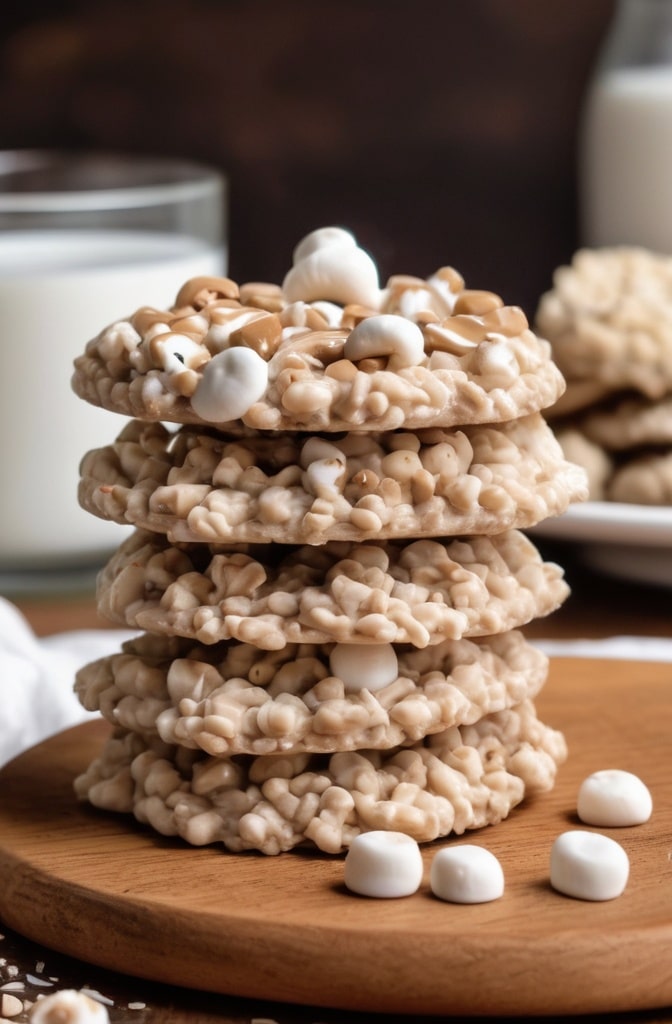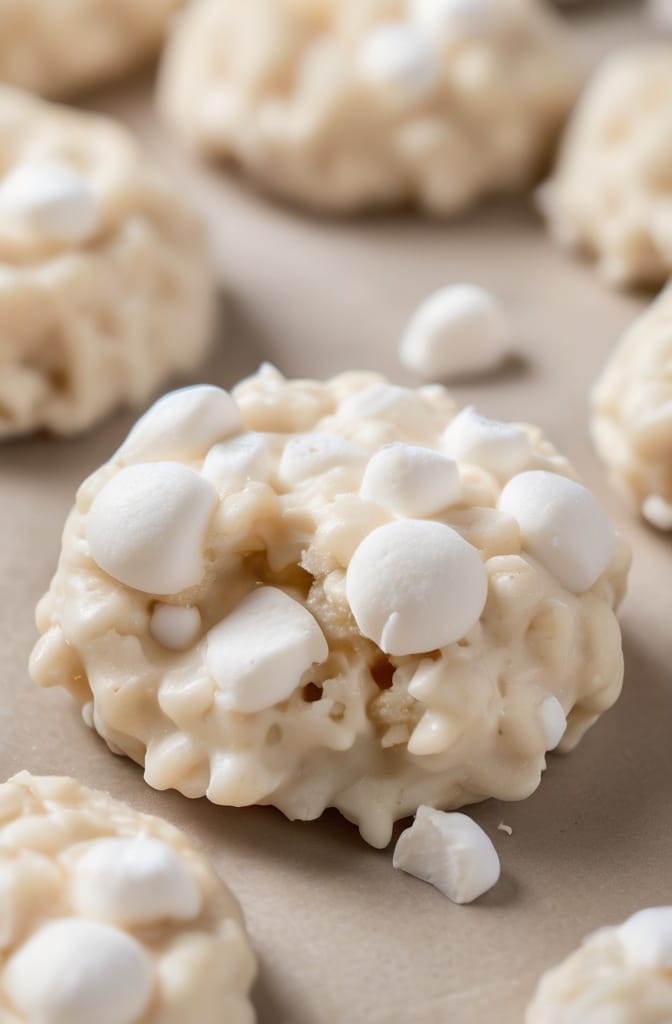A plate of Delicious Avalanche Cookies sat on my counter, still warm, with tiny rivulets of white chocolate cascading over pockets of marshmallow and crispy rice and they were gone within ten minutes. My culinary school colleagues devoured them before I could even snap a photo.
That’s the power of these irresistible treats. Ever wondered why they’re called “Avalanche” cookies? The name comes from the visual cascade of ingredients and textures that tumble together, creating a sweet landslide of flavor that’s impossible to resist making Delicious Avalanche Cookies live up to their name in every bite.
Avalanche Cookies stand apart in the vast universe of cookie recipes becuz they combine the best elements of cookies, candy, and crispy treats into one magnificent creation. They require no baking, making them perfect for hot summer days or when you simply cant be bothered to heat up the oven. What makes these cookies truly special is their adaptability and the interplay of contrasting textures—crunchy cereal, creamy chocolate, and soft marshmallows all harmonizing in a single bite.
Ingredients & Substitutions
Core Ingredients
- 12 oz (340g) high-quality white chocolate, chopped or chips
- 2 tablespoons (30g) unsalted butter
- 3 cups (85g) crispy rice cereal
- 1½ cups (75g) mini marshmallows
- ¼ teaspoon fine sea salt
- ½ cup (90g) semi-sweet chocolate chips
Potential Substitutions and Variations
White chocolate forms the foundation of these cookies, but not all white chocolate is created equal. Look for products with cocoa butter listed in the ingredients—cheaper versions use vegetable oils that won’t set properly. For a dairy-free option, several brands now offer coconut-based white chocolate that melts beautifully and sets with a similar texture.
Rice cereal provides the signature crunch, but don’t feel limited to the classic brand. I’ve experimented with alternatives like gluten-free brown rice crisps, which add a nuttier flavor profile and more complex texture. Crushed cornflakes or even rice chex work suprisingly well, though they’ll alter the final appearance and mouthfeel slightly.
Mini marshmallows are tradicional here, but if you’re vegetarian or vegan, aquafaba marshmallows make an excellent substitute. They melt differently—expect less gooeyness and more of a soft chew. For those avoiding added sugars, unsweetened dried coconut flakes can provide a similar visual effect with a completely different yet complementary flavor dimension.
Step-by-Step Instructions

Preparation Phase
Start by lining a large baking sheet with parchment paper or a silicone mat. This non-negotiable step ensures your cookies won’t stick, and it makes cleanup infinitely easier. If your kitchen runs warm, consider chilling the lined baking sheet beforehand—this helps the cookies set faster once dropped.
Reserve about ¼ cup of the mini marshmallows for topping. This might seem trivial, but it’s one of those small details that elevates the final presentation. The reserved marshmallows create those distinctive white peaks that make Avalanche Cookies instantly recognizable.
Create a double boiler by filling a medium saucepan with about an inch of water and placing a heat-resistant bowl on top. Make sure the water dosent touch the bottom of the bowl. This gentle melting method prevents the white chocolate from seizing or burning, which can happen in microseconds if you’re not careful.
Melting and Mixing
Bring the water in your double boiler to a bare simmer—not a rolling boil. Place the white chocolate and butter in the bowl, stirring occasionally with a silicone spatula. The key here is patience—rushing this step is how most avalanche cookies fail before they even begin. Look for a completely smooth mixture with no lumps or streaks.
Once melted, immediately remove from heat and let cool for exactly 2-3 minutes. This cooling period is critical—if the mixture is too hot when you add the cereal, it’ll become soggy instead of maintaining its delightful crunch. If too cool, it’ll start setting and become difficult to mix evenly.
Add the crispy rice cereal and salt to the melted chocolate mixture, folding gently with a silicone spatula until every piece is evenly coated. The most common mistake at this stage is stirring too aggressively and crushing the cereal. Use a light touch—think of it as folding egg whites rather than mixing cookie dough.
Final Assembly
Wait until the mixture has cooled to just slightly warm before folding in the marshmallows (except your reserved portion) and semi-sweet chocolate chips. If your mixture is still too hot, the marshmallows will melt completely and the chocolate chips will streak—you want them to maintain their integrity while just slightly softening.
Working quickly but carefully, use a medium cookie scoop or two tablespoons to drop mounds of the mixture onto your prepared baking sheet. For a more rustic look, simply scoop and drop; for a more uniform appearance, gently press each mound into a traditional cookie shape while still warm and pliable.
Press a few of the reserved marshmallows onto the top of each cookie while they’re still sticky enough to adhere. This is not just for appearance—these surface marshmallows provide little pockets of extra softness that contrast beautifully with the crispy interior.
Setting and Storage
Allow the cookies to set completely at room temperature, which typically takes about 1-2 hours depending on the ambient humidity and temperature. Resist the urge to refrigerate them to speed up the process—this can cause condensation to form, which makes the cereal soggy and creates a dull finish on the chocolate.
Once set, avalanche cookies can be stored in an airtight container at room temperature for up to 5 days, though they’re at their textural peak within the first 48 hours. Place parchment paper between layers if stacking to prevent them from sticking together. In warmer climates, store in the coolest part of your kitchen, away from direct sunlight or heat sources.
Cooking Techniques & Science
The Role of Fat Crystallization
White chocolate’s setting properties rely on the crystallization of cocoa butter, which creates that satisfying snap when bitten into. Unlike tempered chocolate which forms specific crystal structures, the addition of butter in Avalanche Cookies modifies this crystallization process, resulting in a slightly softer set that still holds its shape but yields easily when bitten.
The cooling curve affects texture dramatically. If you’re making these in a professional environment with temperature control, aim for a consistent 68-72°F (20-22°C) during the setting phase. Home bakers can achieve similar results by avoiding temperature extremes—no setting near hot ovens or in cold refrigerators unless you’re willing to accept textural compromises.
Humidity acts as the silent saboteur of perfect Avalanche Cookies. On particularly humid days above 60% relative humidity, the hygroscopic nature of sugar in both the white chocolate and marshmallows will cause them to absorb moisture from the air, potentially resulting in a stickier, less defined final product. During monsoon season or in tropical environments, consider running a dehumidifier in your kitchen before attempting these cookies.
The Science of No-Bake Structures
Unlike traditional cookies that rely on flour proteins and egg structures, Avalanche Cookies achieve their structural integrity through solidification rather than coagulation or gelatinization. The white chocolate and butter mixture acts as both binding agent and flavor carrier, creating a matrix that suspends the other ingredients.
The proportion of solid ingredients to melted binding agents is crucial for proper texture. Too little white chocolate and the cookies won’t hold together; too much and they become overly firm and lose their delightful contrast between crispy and creamy. The 12 oz of white chocolate to 3 cups of cereal ratio has been tested extensively and provides the optimal balance.
Air incorporation during mixing affects density and mouthfeel significantly. Professional pastry chefs know to fold rather than stir, preserving tiny air pockets between the cereal pieces that create a lighter bite. Those who over-mix will produce denser, less texturally interesting cookies that don’t provide the same satisfying eating experience.
Serving & Pairing Suggestions
Presentation Ideas
For casual settings, arrange Avalanche Cookies on a wooden board with scattered additional marshmallows and chocolate chips to reference their components. The rustic presentation highlights their homemade charm while still appearing intentional and thoughtful.
In more formal contexts, consider a deconstructed approach—place a single cookie on a small plate with a quenelle of vanilla bean ice cream, a light dusting of crushed freeze-dried raspberries for color contrast, and a delicate chocolate tuile for height. The combination elevates the humble no-bake cookie to restaurant-worthy dessert status.

For gifting purposes, stack cookies in a clear cellophane bag tied with raffia and attached to a small bottle of dessert wine or port. The presentation suggests pairing possibilities while offering a complete experience rather than just a sweet treat.
Complementary Flavors and Beverages
The sweet, creamy profile of Avalanche Cookies pairs beautifully with beverages that offer either complementary or contrasting notes. A rich, full-bodied coffee brings out the nuances in the white chocolate while cutting through the sweetness. For coffee service, I recommend a medium-dark roast served black or with minimal cream.
Cold milk provides the nostalgic, classic pairing that never disappoints—the proteins in milk actually reset your palate between bites, preventing sweet fatigue and allowing you to better appreciate the textural elements of the cookie. For adults, horchata with a splash of spiced rum creates an unexpected but delightful accompaniment.
Wine pairings might seem pretentious for cookies, but a late-harvest Riesling or Sauternes creates a remarkable synergy with Avalanche Cookies. The honeyed notes in these wines echo the sweetness of the marshmallows while their natural acidity prevents the pairing from becoming cloying. It’s become my signature dessert offering at dinner parties.
Complete Dessert Ideas
Transform Avalanche Cookies into a show-stopping ice cream sandwich by placing a scoop of slightly softened vanilla bean ice cream between two cookies and rolling the exposed edges in finely chopped toasted nuts or colorful sprinkles. Freeze until firm, about 2 hours, before serving.
For summer gatherings, crush Avalanche Cookies and layer them with macerated berries and whipped cream in clear glasses for an impressive trifle-inspired parfait. The contrast between the rich, creamy layers and bright, acidic fruit creates a balanced dessert that’s greater than the sum of its parts.
During holiday seasons, incorporate seasonal elements—crust and crumble Avalanche Cookies over pumpkin custard in autumn or fold crushed cookies into peppermint ice cream for winter festivities. The versatility of these cookies extends far beyond standalone treats.
Conclusion
The beauty of Avalanche Cookies lies in their contradictions—they’re simultaneously sophisticated and approachable, indulgent yet uncomplicated, nostalgic while remaining fresh and exciting. Their no-bake nature belies the complexity of textures and flavors at play, making them an ideal addition to any serious baker’s repertoire.
Mastering these cookies isn’t about following rules rigidly—it’s about understanding the principles behind the ingredients’ interactions and then adapting them to your particular environment and preferences. Pay attention to temperature, handle your ingredients with respect, and trust your instincts about consistency and texture.
Remember that the most successful Avalanche Cookies celebrate contrast—crispy against soft, sweet against salt, visual simplicity against textural complexity. Once you’ve mastered the basic recipe, consider it a canvas for your own creative expressions, whether through the addition of freeze-dried fruits, textural elements like toasted coconut, or unexpected spices like cardamom or chile. The avalanche is just the beginning of your journey.
FAQs About Delicious Avalanche Cookies
Why did my white chocolate seize up when melting?
White chocolate seizes most commonly when it comes into contact with even tiny amounts of water or when overheated. Make sure your bowl and utensils are completely dry before beginning, and always use gentle heat with a double-boiler rather than direct heat or microwave. If it does seize, sometimes adding a teaspoon of neutral vegetable oil and whisking vigorously can rescue it.
Can I make these cookies ahead for an event?
Absolutely! Avalanche Cookies actually benefit from making them 12-24 hours in advance, which allows the flavors to meld and textures to fully set. Store them in a single layer in an airtight container at cool room temperature. They maintain peak quality for about 2-3 days, making them ideal for preparation before parties or gift-giving.
My cookies aren’t holding their shape. What went wrong?
The most common culprit is incorrect white chocolate to cereal ratio. Ensure you’re using proper measurements—weight is more reliable than volume for the white chocolate. Another possibility is insufficient cooling time before shaping. If you’re in a particularly warm environment, try chilling the mixture for 3-5 minutes before scooping. As a last resort, adding an additional ounce of melted white chocolate to the mixture can help bind ingredients.
How can I make these cookies less sweet?
Balance is key with Avalanche Cookies. Try using bittersweet chocolate chips instead of semi-sweet, increase the salt to ½ teaspoon, or add 2 tablespoons of unsweetened cocoa powder to the white chocolate mixture. Some professional bakers incorporate a tablespoon of instant espresso powder, which doesn’t make the cookies taste like coffee but does temper the sweetness while adding complexity.
Can I freeze Avalanche Cookies?
While technically possible, freezing isn’t ideal for these cookies as the thawing process can compromise their texture. The marshmallows become tough rather than tender, and the crispy cereal may absorb moisture during thawing. If you must freeze them, wrap each cookie individually in plastic wrap, then place in an airtight container. Thaw completely at room temperature before serving—about 2 hours on a wire rack to allow air circulation.

